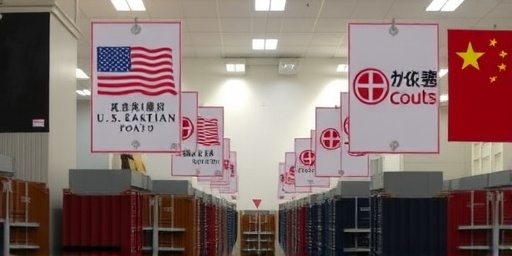As the clock struck midnight on Sunday, a wave of new tariffs on Chinese imports officially activated, sending ripples through global markets and heightening fears of renewed inflation in the U.S. economy. These duties, ranging from 10% to 25% on over $300 billion worth of goods, stem from the latest round of U.S.-China trade negotiations between President Donald Trump and Chinese President Xi Jinping. While the adjustments aim to protect American industries, economists warn that they could drive up consumer prices by as much as 2-3% in the coming months, complicating the Federal Reserve’s efforts to stabilize the economy.
The tariffs target a broad array of products, including electronics, apparel, machinery, and critical components for the automotive sector—key areas in the ongoing U.S.-China trade tensions. This move comes just weeks after a fragile truce was announced at the G20 summit, where both leaders agreed to modest reductions in some rates but maintained pressure points to encourage fairer trade practices. Early market reactions were swift: U.S. stock futures dipped 1.5% at open, while the yuan weakened against the dollar, underscoring the immediate strain on bilateral relations.
Tariff Details Emerge from Trump-Xi Talks: What’s New and What’s Unchanged
The foundation of these tariffs was laid during the high-stakes phone call between Trump and Xi last month, where discussions focused on intellectual property theft, forced technology transfers, and agricultural purchases. According to a White House briefing, the adjusted rates represent a compromise: the baseline 25% tariff on $250 billion of goods remains intact, but a new 10% levy applies to an additional $50 billion in consumer-oriented imports like toys and footwear. This selective approach, officials say, is designed to minimize disruption to everyday Americans while hitting Chinese exporters hardest.
Inside the Beltway, reactions are mixed. Commerce Secretary Wilbur Ross hailed the implementation as “a victory for American workers,” emphasizing that the tariffs would incentivize companies to relocate manufacturing back to the U.S. However, the U.S. Chamber of Commerce issued a stark warning, stating in a press release: “These tariffs are a tax on U.S. businesses and consumers, potentially adding $1,000 to the average household’s annual expenses.” Data from the Peterson Institute for International Economics supports this, projecting that U.S.-China trade volumes could shrink by 15% in the next quarter alone.
To illustrate the scope, consider the electronics sector: smartphones and laptops from brands like Huawei and Lenovo now face the full 25% hit, prompting retailers such as Best Buy to announce price hikes of up to 15% on affected models. In agriculture, while soybeans and pork exports to China saw temporary relief with a 90-day purchase commitment from Beijing, the overall uncertainty lingers, affecting Midwestern farmers who rely on these markets for 40% of their revenue.
Inflation Alarms Sound as Consumer Prices Prepare for Uptick
At the heart of the tariff rollout’s controversy is its potential to reignite inflation, a concern that’s kept Federal Reserve Chair Jerome Powell awake at night. With core inflation already hovering at 2.1%—just above the Fed’s target—these new duties could push it toward 3%, according to forecasts from Goldman Sachs. The mechanism is straightforward: as Chinese suppliers pass on costs, U.S. importers absorb the tariffs, leading to higher consumer prices for everything from washing machines to winter coats.
A recent survey by the National Retail Federation revealed that 72% of retailers plan to raise prices on tariff-impacted goods within 60 days, with apparel and home goods leading the charge. For instance, Walmart, which sources 70-80% of its non-food inventory from China, has already signaled adjustments that could increase the cost of a basic T-shirt by 20 cents—small individually, but cumulative across shopping carts nationwide. Economists like Mark Zandi from Moody’s Analytics predict that this could erode recent wage gains, with low-income households feeling the pinch most acutely, as they spend a larger share of income on imported essentials.
Historical parallels abound; during the 2018 tariff escalations, consumer prices for steel-intensive products rose 9.5%, per U.S. Bureau of Labor Statistics data. Now, with supply chains still recovering from the COVID-19 disruptions, the added layer of tariffs exacerbates vulnerabilities. “Inflation isn’t just a number on a chart; it’s the grocery bill that families can’t escape,” noted Consumer Federation of America President Stephen Brobeck in an interview. The Fed’s response remains uncertain—Powell has hinted at possible rate adjustments, but with unemployment at historic lows, aggressive hikes could tip the economy into recession.
Manufacturing Sector Braces for Supply Chain Overhaul
For U.S. manufacturing, the tariffs represent both a shield and a sword. On one hand, they aim to bolster domestic production by making Chinese alternatives less competitive; on the other, they disrupt intricate global supply chains that American firms have built over decades. The Reshoring Initiative reports that since 2017, over 1,800 companies have announced plans to move operations back to the U.S., citing trade policies as a primary driver. Yet, implementation is slow—full transitions can take 2-5 years and cost billions.
Take the auto industry as a prime example: Ford and General Motors, which import $20 billion in parts annually from China, now face tariffs that could add $1 billion to their costs. CEO Mary Barra of GM stated in a congressional hearing last week, “We’re diversifying suppliers to Mexico and Vietnam, but short-term disruptions are inevitable, potentially delaying production lines by weeks.” Similarly, in semiconductors—a sector where China dominates 60% of global assembly—tariffs threaten to bottleneck innovations in AI and 5G, prompting calls from tech giants like Apple for exemptions.
Positive signs emerge too. A study by the Alliance for American Manufacturing projects that sustained tariffs could create 140,000 jobs in steel, aluminum, and machinery by 2025, particularly in Rust Belt states like Ohio and Pennsylvania. Companies such as Nucor Steel have ramped up hiring, with output increasing 12% year-over-year. However, small manufacturers aren’t as fortunate; the National Association of Manufacturers survey shows 65% reporting higher input costs, squeezing margins and forcing some to idle plants. As one Midwest factory owner put it anonymously to Reuters, “These tariffs are like a double-edged blade—we want to compete, but we’re bleeding cash in the process.”
To navigate this, many firms are turning to automation and nearshoring. Investments in robotics have surged 25% in tariff-exposed sectors, per McKinsey data, aiming to offset labor costs while reducing reliance on overseas imports. Yet, the transition isn’t seamless; workforce retraining programs, funded partly through the CHIPS Act, lag behind, leaving skilled labor gaps in key areas like advanced welding and circuit design.
Economists and Industry Leaders Debate Long-Term Trade Ramifications
The tariff activation has ignited a fierce debate among experts on the future of U.S.-China trade. Optimists, including Trump’s trade advisor Peter Navarro, argue that these measures will force structural reforms in Beijing, leading to a more balanced global economy. “Tariffs are the only language China understands,” Navarro asserted in a Fox News appearance, pointing to increased U.S. LNG exports to China as evidence of leverage at work.
Skeptics abound, however. Harvard economist Dani Rodrik warns that prolonged tariffs risk a “trade war spiral,” estimating a 0.5% drag on U.S. GDP growth over the next two years. International voices echo this; the European Union, through Trade Commissioner Valdis Dombrovskis, expressed concerns that diverted Chinese exports could flood European markets, prompting retaliatory measures. In Asia, countries like Vietnam and India stand to gain, with foreign direct investment inflows up 30% as firms reroute supply chains— a boon for their manufacturing sectors but a loss for U.S. efficiency.
Consumer advocacy groups highlight the human cost: AARP analysis shows seniors on fixed incomes could see medication prices rise 5-10% due to tariffed pharmaceutical ingredients from China. Quotes from Capitol Hill reflect the divide—Senator Chuck Schumer (D-NY) called for “targeted relief for vulnerable sectors,” while Representative Kevin Brady (R-TX) praised the tariffs as “essential for national security.” Polling from Pew Research indicates public support at 55%, down from 2018 highs, as inflation fears take hold.
Looking ahead, the next phase hinges on upcoming WTO consultations and a potential Trump-Xi summit in November. If compliance falters, additional tariffs on $100 billion more in goods loom, per U.S. Trade Representative Katherine Tai. Businesses are hedging bets: inventory stockpiles have ballooned 20%, per Census Bureau figures, in anticipation of further escalations. For consumers, budgeting apps and price-tracking tools are seeing record downloads, signaling a shift toward thriftier habits amid rising costs.
Ultimately, the tariffs’ legacy will depend on negotiation outcomes. If they catalyze genuine U.S.-China trade reforms, they could fortify American manufacturing for decades. But if tensions escalate, inflation could persist, consumer prices could soar further, and global supply chains might fracture irreparably—leaving economists to ponder whether protectionism is a cure or a costly illusion.









